
The black-lyre leafroller moth is a tortrix moth species of the family Tortricidae.

Ischalis is a genus of moths in the family Geometridae. The genus was erected by Francis Walker in 1863. All species within this genus are endemic to New Zealand.
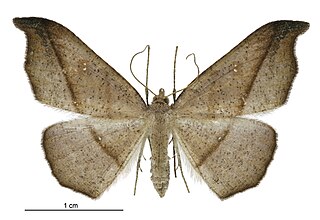
Sarisa is a monotypic moth genus in the family Geometridae and was first described by David Stephen Fletcher in 1979. The genus contains only one species, Sarisa muriferata, the hook-tip fern looper, which is endemic to New Zealand and surrounding islands. This species was described by Francis Walker in 1862. It is widespread in the North and South Islands, and has been recorded from Stewart Island, Big South Cape Island, the Chatham Islands and the Auckland Islands.

Zermizinga is a moth genus in the family Geometridae erected by Francis Walker in 1863. Species within this genus include Zermizinga sinuata, the lucerne looper or spider moth, which was described by Warren in 1897, as well as Zermizinga indocilisaria, which was described by Walker in 1863.

Sabatinca incongruella is a species of moth of the family Micropterigidae. It is endemic to New Zealand and is found only in the northern parts of the South Island. It is a day flying moth and is on the wing from mid January until late February. The larvae of this species feed on liverworts and the adult moths feed on the spores of fern species in the genus Pneumatopteris. This species can be confused with S. chalcophanes as it is very similar in appearance.
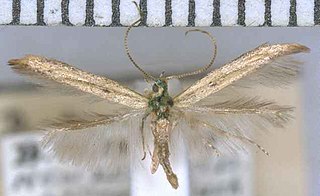
Batrachedra arenosella, the armoured scale eating caterpillar or the coconut moth, is a species of moth of the family Batrachedridae. It was first described by Francis Walker using specimens collected in Auckland, New Zealand. It has been hypothesised that the New Zealand moth may contain two distinct species. As well as the moth species in New Zealand, this name has been applied, perhaps incorrectly, to moths found in India, Indonesia, the Malay Peninsula, and Réunion, as well as in Australia, from the Northern Territory and northern Queensland to New South Wales and South Australia.
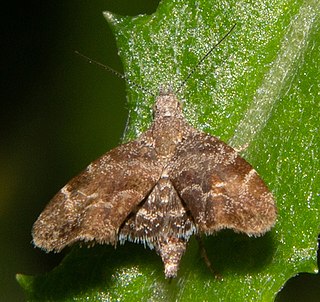
Asterivora combinatana is a species of moth in the family Choreutidae. It is endemic to New Zealand and has been observed at locations in both the North and South Islands. The larvae feed on Senecio bellidioides and Brachyglottis repanda either from within a silken gallery or alternatively a silken curtain under which they feed. It is double brooded with adults being on the wing from September until November and again from February until April. This species is a day flying moth. It is extremely variable both in colouration and in size. The female tends to be larger and paler than the male of the species.

Eudonia submarginalis is a species of moth in the family Crambidae. It was described by Francis Walker in 1863. It is endemic to New Zealand.

Culladia cuneiferellus is a species of the family Crambidae in the genus Culladia. It was described by Francis Walker in 1863. It is found in Australia, New Caledonia, Norfolk Island, the New Hebrides and the Loyalty Islands. It is also present in New Zealand.

Eudonia sabulosella is a species of moth in the family Crambidae. This species is endemic to New Zealand and is regarded as being common. The larvae of this species are known to damage pasture in New Zealand.
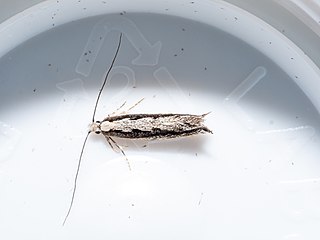
Erechthias fulguritella is a species of moth in the family Tineidae. It was described by Francis Walker in 1863. This species is endemic to New Zealand.

Erechthias terminella is a species of moth in the family Tineidae. It was described by Francis Walker in 1863. This species is endemic to New Zealand.

Eschatotypa derogatella is a species of moth in the family Tineidae. It was described by Francis Walker in 1863. This species is endemic to New Zealand.

Tingena is a genus of the concealer moth family (Oecophoridae). This genus is endemic to New Zealand.
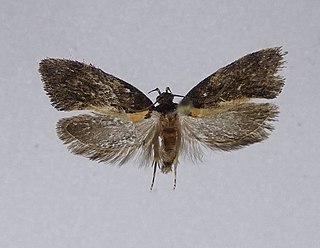
Tingena basella is a species of moth in the family Oecophoridae. It is endemic to New Zealand and has been found in both the North and South Islands. The preferred habitat of this species is scrubland or light forest. Eggs are deposited either singly or in egg masses. The larvae are littler leaf feeders. The adults of this species are on the wing from October through to the middle of December. George Hudson stated that he had collected numerous specimens of both sexes amongst the flowers of Brachyglotis repanda.

Tingena plagiatella is a species of moth in the family Oecophoridae. It is endemic to New Zealand and has been observed in both the North and South Islands. This species inhabits light native bush or scrubland. Adults of this species are on the wing from November to January.
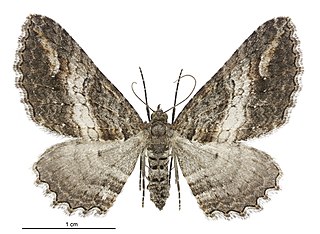
Horisme suppressaria is a moth of the family Geometridae. This species was first described by Francis Walker. Currently the taxonomy of this species is uncertain and as a result this species is also known as Horisme (s.l.) suppressaria. The species is endemic to New Zealand and has been observed in both the North and South Islands. The larval hosts of H. suppressaria are species in the genus Corokia including Corokia cotoneaster.
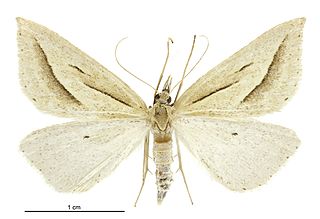
Samana falcatella is a species of moth in the family Geometridae. This species is endemic to New Zealand.

Cnephasia incessana is a species of moth in the family Tortricidae first described by Francis Walker in 1863. However the placement of this species within the genus Cnephasia is in doubt. As a result, this species may be referred to as Cnephasia (s.l.) incessana. This species is endemic to New Zealand.

Prothelymna antiquana is a species of moth in the family Tineidae first described by Francis Walker in 1863. This species is endemic to New Zealand.





















